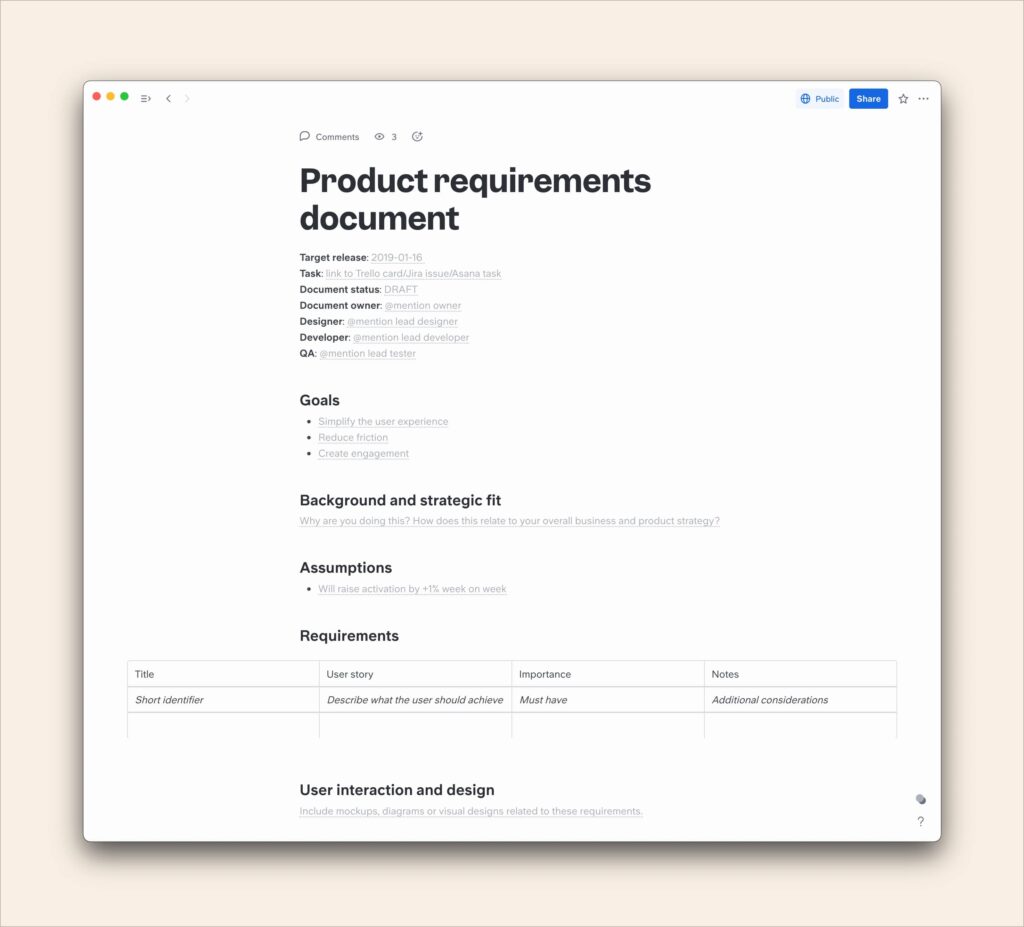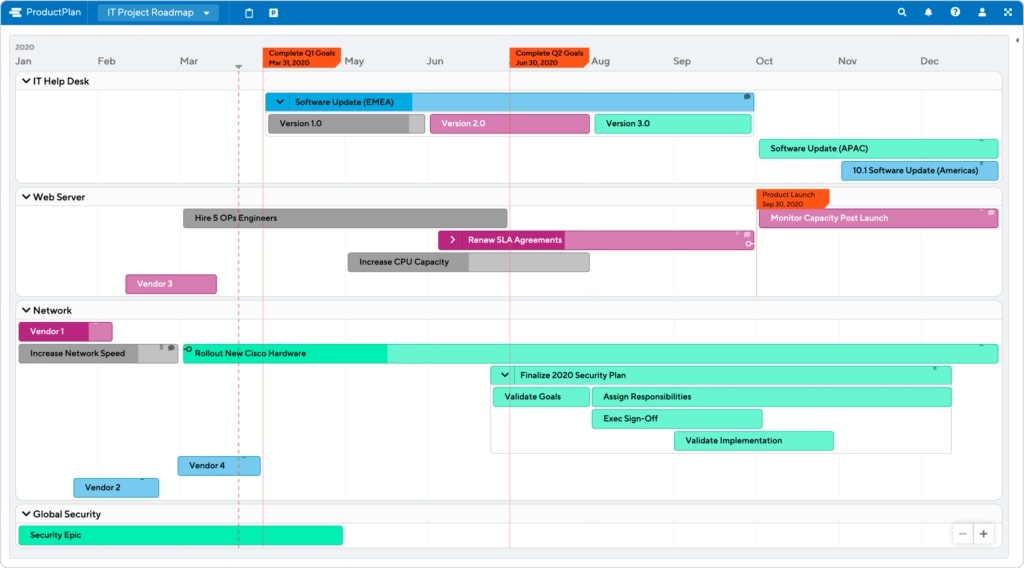Whether your business has a new idea or your customers are demanding a new product, you cannot just communicate it to the development team and expect them to build it. It is essential to go in with a well-orchestrated plan that ensures seamless product development from inception right down to the final phase.
You need a clear product roadmap that allows the design, development, and quality assurance teams to be on the same page and deliver on outlined specifications.
A product requirements document or PRD helps project managers to streamline the entire process.
Let’s take a deep dive into PRD and how it enables businesses to create an elaborate product roadmap for resource-efficient product management.
What is a Product Requirements Document (PRD)
A product requirements document is an official instrument used to convey the features and functionalities of a new product.

Credits: Slite
Also known as a product roadmap document, PRDs lay out a diverse range of characteristics, requirements, and specifications along with terms and conditions for the design and development stages. Product roadmaps:
- Allow you to get a big picture of a prospective product.
- Estimate the cost of each step and all the important tasks of the development process.
- Give you an indication of how long it takes you to complete key product goals.
- Promote a sense of unity among the team members.
- Mitigate some of the problems that arise throughout development.
A product roadmap does not only highlight the primary objective and unique value proposition of a product but its timeline and future goals as well. This enables the business to craft a product strategy that focuses on delivering customer benefits.
Components of a Product Roadmap Document
There are five fundamental components that a product roadmap document must contain. These include:
Primary Purpose
This describes the high-level goals and objectives of the proposed product to set the strategic direction. It tells all the stakeholders what they need to accomplish at the end of development.
Features
This is where product managers highlight all the features in detail with a clear use case, requirements, and context. The more complex your features are, the more you must incorporate bullet points and sub-headings to make them more approachable for all the teams.
Basic Design Guidance
The product design team must provide general instructions and guidance on how developers must approach the UI and UX of the product.
System and Environment Specifications
To write an effective product roadmap, you must include all the end-user systems that the proposed product must be compatible with. This includes operating systems, and browsers, among others.
Estimated Timeline
Without a timeline, product roadmaps remain incomplete. You should have a target release window along with major project milestones and release dependencies.

Credits: Product Plan
Apart from the aforementioned factors, a PRD must cover the release criteria in terms of key indicators including performance, usability, functionality, compatibility, and reliability.
Who Writes a Product Roadmap
Building product roadmaps is one of the major responsibilities of product owners or product managers. They don’t only have a better understanding of the competitive landscape but also know how products evolve in a given time frame and when they need to add new functionality to keep customers satisfied.
Any member of a product team has the ability to create a product roadmap specifying all the new features. That said, a top-down approach remains more desirable for most businesses as product owners or managers are key stakeholders in the process.
These professionals are in a better position to lead and guide internal teams in executing a coherent product vision.
Moreover, a product manager is far more experienced in implementing agile development practices to provide what customers are looking for.
They also have the ability to drive agile teams in the same direction to achieve shared goals and work on multiple products at a time to keep product backlog lean and clean.
Writing a Product Roadmap Document
To write a comprehensive and detailed product roadmap document, you need to break the entire process down into multiple steps. This provides you with a sense of clarity to follow through and create effective product roadmaps for your internal stakeholders.
Keep in mind that you have two ways to approach preparing a PRD. The first is to build an internal roadmap for product management teams. The second is an external roadmap that acts as a public communication tool or announcement for external stakeholders.
Phase 1: Conduct Detailed Research
It is impossible to design a successful new product without first understanding the problems the product solves. Conducting research is the only way to get valuable information.
Take time to get to know your target audience and listen to them. Find out what their issue is and how your product helps them manage it.
Take a closer look at your competition. Investigate their approaches to resolving the issue. Analyze your competition’s strong and weak points in tackling the issue based on what you’ve learned from your clients.
Outline how you intend to help them. Ask for help from everyone competent to shed light on the issue. This includes the design, marketing, and sales teams, among others.
Evaluate the talents of your staff. Identify if they have the necessary tools to deal with the issue, for instance, the right product roadmap software.
When it comes to solving the issue, assess the availability and functionality of solutions your product development team has experience with. Examine the tools at your disposal and their specific features and drawbacks.
Phase 2: Define Product’s Purpose and Key Characteristics
The next step in the product roadmap writing is to use the information acquired in the research phase and craft a brief, clear statement of purpose for the product.
This statement must communicate the unique value proposition and how it helps your brand achieve its short and long-term goals.
Once you have sorted out the primary purpose, draft a set of characteristics that defines your product.
For example, if you are developing a software-as-a-service (SaaS) product, the characteristics are user-friendliness, data security, and reliability. At one point, you need to explain all the details at the feature level but this isn’t that moment.
The biggest benefit of adding the main purpose and features in a product roadmap is to set product teams on a path to success. They get a clear picture in terms of how the business wants to serve its customers. This is also a part of your external roadmap.
Phase 3: Build a User Profile and Avatar
A brand’s ideal client is a person who meets all of the criteria in their personal and professional lives. An avatar is nothing more than a fictitious figure created to represent a potential client to help your product team visualize the end user.
Creating an avatar for your product roadmap is important for two main reasons.
For starters, avatars summarize user stories. These help to flesh out the details you have about potential product users. This provides product teams with a structured way to gain as much information as possible about your product users to help you build customer-centric user experiences.
The second reason is that although this looks like an external exercise, it’s a part of your internal roadmap. You don’t look at the individuals in the real world to narrow down the characteristics of your avatar; instead, you look at your product.
Businesses that have a thorough grasp of their products build more authentic avatars. This way you enrichen your product roadmap with the right information that the development, marketing, and sales team need to put the product on a path to success.
Phase 4: Outline Technical Requirements
The next part of the product roadmap document focuses on the internal roadmap to define the product strategy.
Fundamental Business Requirements
This part contains a more detailed overview of the new or improved product. Teams must define target users along with each one’s specific and non-specific needs. Utilize client personas and avatars to better understand your target audience.
Development Team Requirements
Establish the product’s software needs and other relevant development specifications for your team. You must include the frontend, UI/UX, libraries, system integrations, and other resources in this section.
Providing the development team with the right product road mapping software is critical for any executive team. For example, Jira roadmaps help to achieve strategic goals and enable agile methodologies.
Design Requirements
Identify the aspects of the product that you need to take into account while building it. Mention whether it must be compatible with the current infrastructure as well as the limitations that are a part of the project’s scope.
Create the performance specifications using user stories and customers’ feedback. Compose them in the present tense to convey the final product’s functioning and usability to the reader.
Building and Deployment Requirements
List all of the hardware and software components, interfaces, and analysis tools needed to build the product. Create a set of standards to ensure the smooth completion of the product by ensuring that the team meets the needed capabilities, user testing, sign-off documentation, and other requirements.
Every product owner must remember that company goals and the requirement for new features evolve so they need to keep their product roadmaps adaptive using an agile development approach.
Phase 5 – Testing, Support, and Compliance Requirements
You have the ability to streamline product management by including detailed information about the testing, support, and compliance needs of the new product. Make it an essential part of your product strategy and add these points to every roadmap.
- When you are writing a product roadmap, it helps to assign a version to every release. That’s why product leaders recommend including release notes, references, and dates in the roadmap document.
- It is crucial to articulate the evaluation criteria for all product features in detail to guarantee that the product will meet all performance standards. Be certain to cover both automated and manual testing as well as integration and failure testing.
- Explain the support requirements for each product in detail, which features documentation for support staff to consult. Create a system that recognizes and addresses the problems that users have.
- While you’re developing the product, the development team must be aware of the fundamental compliance criteria that they have to satisfy. Accessibility standards, the expected time frame, and mobile development standards all fall under this category.
Product Roadmap Document: Get to Writing
No product leader creates the perfect product roadmap on their first attempt.
Your product roadmap needs to go through more than one revision by the internal team to ensure they align with company goals while addressing the needs of your customers.
Don’t forget that achieving success with your product roadmap document depends on your ability to communicate. That’s what you need to focus on when writing a product roadmap.
Best of luck!